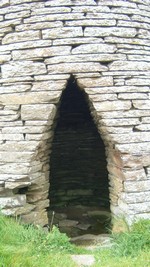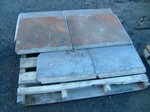|
|
ENGLISH STONE FORUM |
|
..
|
Home
> Issues > Geologists guide to English building
stones 1
| 2
|
|
|
A
Geologisit's guide to English building stones
Eric Robinson Stone used in buildings varies from place to place throughout England, to an extent that makes it an impossible task to write a short article which will explain every aspect in sufficient detail from the perspective of a geologist. For this reason, what follows is an attempt to review the basic features and introduce some of the language used by architects and art historians in describing stone, and to a lesser extent, by the trade. Geological terminology may come a poor fourth. Recently, the production of geological guides to the built environment has been in vogue, and these have greatly increased the engagement of the public at large with natural stone, and its geological aspects. It is the intention of this article is that you shall test what is said wherever you happen to live, looking at buildings in your local town centre, making your own assessment of what stone has been used in the past, and what stone is being used present-day. It can be useful to judge how well stone has stood up to weathering and local conditions; contrasts between regions can be quite strong. As with other practical studies, theory and book-knowledge are important, but there's nothing quite like practical experience. In this, with only a little experience, it should be possible for you to write your own stonework guide to your home town. |
 . . |
The
material substance
In extremis, almost any stone can be used in building solid, lasting structures in place of lean-tos or shelters. In stone-poor country, anything from rounded beach boulders to erratics taken from boulder clays, can become the basis of walls, difficult as it may be to bond them together into a self-standing structure. Otherwise, sandstone soft enough to cut and dress may be chosen even with doubt as to its lasting quality. In stone-poor country, man makes the best of a bad job unless he is prepared to travel afar and equally, to pay for the transport of bulky stone from the best sources. The best building stones in all parts of the world have come to be recognised by experience and by reputation to the extent that they have been sought and commissioned in spite of cost. Into this category fall the white marbles of the Greek islands and the cream coloured limestone from Caen in Normandy. In the last century, with the efficiency of rail and sea transport at low costs, there are few restrictions on the use of stone of quality from all parts of the world. |
| .. | A
stonework vocabulary
In reading about stone, you will quickly find that there are at least two distinct languages employed. There is the geological patois which will probably be familiar to you already, but in parallel with it will be the language of the Trade which tends to have its own terms. These include words such as ashlar, freestone, ragstone, flagstone, as well as the comprehensive term, dimension stone. This last term refers to any stone (igneous, sedimentary, or, to a lesser extent, metamorphic), which can be cut from the quarry bed to precise and regular dimensions. Within this term in fact we have defined a quality of good building stone which will determine its cost and rating in any roll. This applies especially in modern building practice, when good stone is sliced into thin cladding slabs to be attached as a skin to a steel framed building. Regular blocks of good dimension stone allow the most economical slicing from the original block with least waste in the process. |
| . | Well-jointed
massive sandstones, or regularly bedded limestones qualify immediately
as good dimension stones, as would the inner core of granite intrusions,
criss-crossed by cooling joints along which the stone can be worked from
the quarry face. In contrast, cross-bedded channel-form sandstones, or
lenticular limestones all fail the dimension stone test through their irregularity
of mass, which prevents the calculated supply of regular sized blocks.
Also excluded would be stone with a particularly strongly bedded texture,
derived either from flat platy minerals such as micas, or shell content
concentrated into thin beds, either of which would determine an ease of
splitting which could be troublesome. Good as a flagstone, and valued for
just that splitting quality, they would not reach the standard required
of good dimension stone.
Within dimension stone, there are categories which are often referred to as freestone. These are stones which literally can be freely dressed in any direction, including their shaping into fully three-dimensional sculptural work if need be. Many dimension stones could qualify, but best of all must be the even-grained ma ssive sandstones lacking strong lamination or bedding, their roundec or semi-rounded grains interlocking neatly, and their pore space fillet with cementing lime of silica to give a firm bonding to the stone overall. Equally effective may be oolitic limestones (Bath Stone and/Portland Stone both come to mind) simply because they share the same homogeneity of composition and texture which allows them to break in directions determined by hammer and chisel blows with a clean fracture. Just this property in the grainy Carboniferous Limestone from Wirksworth in Derbyshire (Hopton Wood Stone) made this the chosen material of the sculptors Henry Moore and Barbara Hepworth for their larger works, often with continuous smooth surfaces which would, have been difficult to achieve in other stones with a stronger grain. |
 |
Some
of the best freestones are medium-to-fine grained sandstones well distributed
throughout the country. To allow you to identify with all this, here are
some regional examples: Grinshill Stone (Shropshire), Runcorn Stone (Cheshire),
Woolton and Rainhill Stone (Lancashire), Mansfield Stone (Nottinghamshire)
Stancliffe and Stanton Stone (Derbyshire), Park Spring (Yorkshire St Bee's
and Penrith Sandstone (Cumbria), Dunhouse and Springwell (Durham), Blaxter,
Prudhamstone (Northumberland). All of these are sandstones and range in
age from Carboniferous to Triassic (New Red Sandstone), all occur from
the North Midlands northwards into Scotland.
Limestone freestones include Portland Stone (Dorset), Beer Stone (Devon), Doulting Stone (Somerset, although rather coarse in grain), Bath Stone (Gloucestershire/Somerset), Taynton Stone (Oxfordshire), Ketton Stone (Rutland), Ancaster Stone (Lincolnshire). To redress any North-South imbalance, all of these prime limestone freestones are from south of the Trent, and are of Jurassic age except for Beer Stone, which is a harder form of chalk. Freestones of any age or character allow what is termed an ashlar finish, which simply means that they have the quality to allow the production of a smooth even surface by the tooling and rubbing down of the surface. Well-laid ashlar, accurately finished, produces the narrowest of joints between blocks in masonry, and the sheerest of unbroken walling. |
| . | In marked contrast to ashlar, some excellent building stones possess a coarser, rougher texture that can be exploited in quite a different finish to cut blocks. The terms covering this range include rock-faced, rusticated and bolstered, such facings taking into account the rougher texture of the stones. All these treatments are designed to give a rugged, solid appearance to masonry and are often seen to best effect in the older banks in town centres seeking to give an air of solid security to potential customers. Amongst the stones that lend themselves to such treatments are the granites, but also the shelly limestones which are often termed ragstone on account of their rough textures derived from the wealth of shell debris which they contain. Good examples would be Kentish Ragstone (a Cretaceous greensand), or Barnack Rag (Jurassic Lincolnshire Limestone). |
 |
Flagstone
has been mentioned already, and is a term that hardly needs definition,
except to say that its flat, slabstone character, the very thing that makes
it most suitable for paving, is not confined to sandstones (a geological
definition), but can equally apply to slates, limestones, and some igneous
rocks (ashes and tuffs). Again, we are dealing with a 'usage' term and
one which is descriptive and as such, quite independent of composition.
As much is true of marble, which to the Trade and to architectural historians, often simply means a stone which can take and retain a polish. As such, it can apply to limestones or igneous rocks without there needing to have been alteration by heat or pressure – the basis of the metamorphism required to fulfill the geological definition of marble. One other detail that is important for marbles must be the pattern of veining or streaks of contrasting colour, which give a distinctive 'figure' to the rock. Usually such patterns stem from the mineral impurities that occur in most limestones (often clay minerals), these separating out in the course of recrystallisation of the original limestone. |
| . | Marbles
are often the decorative touches added to buildings, most often in the
entrance foyer or facing the lift shafts of the interiors where they are
protected from aggressive weathering. As a rule, in a British-type climate,
marbles are not for external use as they were in History in the Mediterranean
countries.
True marbles one is likely to meet in English buildings include the grass-green Iona, or the very similar Connemara Marbles of similar Dalradian age (i.e. of late Precambrian or early Palaeozoic age). Other named marbles are almost entirely unaltered or only slightly altered limestones such as the Devonian-age Torquay and Plymouth Marbles of South West England, famous for their richness in fossil corals, and their rich deep colours. Derbyshire and Pennine Marbles are invariably unaltered Carboniferous Limestones in which the 'figure' is contributed by crinoid ossicles (Dene Stone or Derbyshire Fossil is the distinctive polished stone which faces the foyers and the stair cases of the Royal Festival Hall on the South Bank, adding a touch of geology to what might otherwise be a purely artistic outing). Other so-called marbles, often referred to for their colour as 'red' or 'black' marble, may turn out to be igneous rocks including basalt, dolerite, gabbro or serpentinite. |
| .. | Continues |
| .. | 1 | 2 |
| ... |
|